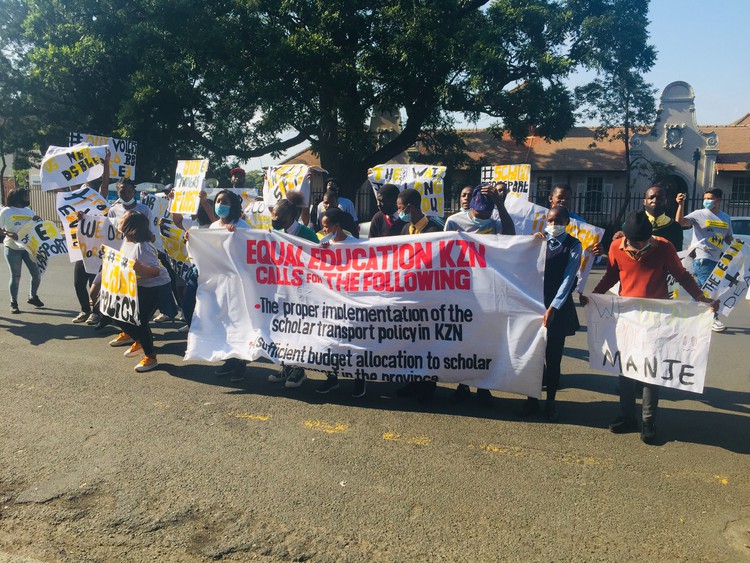Activists welcome release of scholar transport policy in KZN
Learners with disabilities attending public schools are included
Equal Education members picketed outside the Department of Education’s offices in Pietermaritzburg in April this year, demanding that the final provincial Learner Transport Policy document be released. Archive Photo: Nompendulo Ngubane
- The KwaZulu-Natal departments of Education and Transport have finally released the provincial Learner Transport Policy.
- Equal Education and the Equal Education Law Centre have welcomed this as a victory after a seven-year battle with the provincial government.
- The final policy includes learners with disabilities at public schools.
The KwaZulu-Natal departments of Education and Transport have released a long-awaited Learner Transport Policy which clarifies the criteria for providing school transport to learners in the province.
Equal Education (EE) and the Equal Education Law Centre (EELC) said this was a victory after seven years. In a statement on Wednesday, they said the provincial departments of Education and Transport “have at last applied themselves to addressing the need for safe, reliable, government-subsidised learner transport across the province”.
GroundUp reported in April on a picket outside the education department’s offices in Pietermaritzburg by learners and members of EE who were demanding that the Policy be released. EE said more than 370,000 learners qualified for scholar transport in the province but there was no clear policy.
Since 2014, EE has campaigned for better scholar transport in KZN, eventually taking the department to court in November 2017. The department had promised that by 31 December 2018 it would release a provincial scholar transport policy, but it failed to do so.
In October 2019, the department again promised to release the policy by January 2021 and again failed to do so. The organisations were surprised last month to discover that the policy had already been approved by the KZN cabinet in June 2021 and has been in effect since 1 July.
“Our #LongWalkToSchool campaign has its roots in the experiences of EE learner members attending schools in Nquthu, KZN, who testified to walking punishing distances on foot to and from school, often over difficult and dangerous terrain in severe heat or rain, and vulnerable to theft and sexual assault,” EE said.
Unlike the draft policy released earlier this year, the final policy now includes learners with disabilities attending public schools. It allocates mostly administrative responsibilities to the education department and mostly operational responsibilities to transport.
“The policy mentions deadlines and time frames around certain areas. For example, it outlines that principals should determine whether learners require transport and identify these learners by the end of the third term. The criteria for learners with disabilities is comprehensively detailed, to ensure that learners with disabilities, who attend both public ordinary schools and public special schools, are properly considered and provided with transport,” said EE.
“The criteria for prioritising schools has now been detailed in the final policy.”
Next: Busiswa Pikinini has no hands, no feet - and no house
Previous: MyCiTi N2 route to open again early next year, promises new Cape Town transport chief
© 2021 GroundUp. This article is licensed under a Creative Commons Attribution-NoDerivatives 4.0 International License.
You may republish this article, so long as you credit the authors and GroundUp, and do not change the text. Please include a link back to the original article.
We put an invisible pixel in the article so that we can count traffic to republishers. All analytics tools are solely on our servers. We do not give our logs to any third party. Logs are deleted after two weeks. We do not use any IP address identifying information except to count regional traffic. We are solely interested in counting hits, not tracking users. If you republish, please do not delete the invisible pixel.



